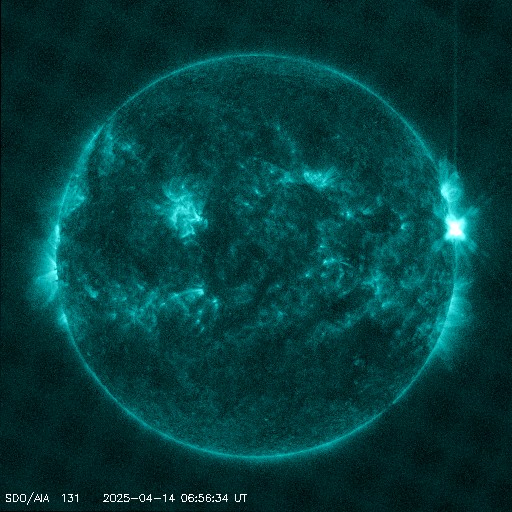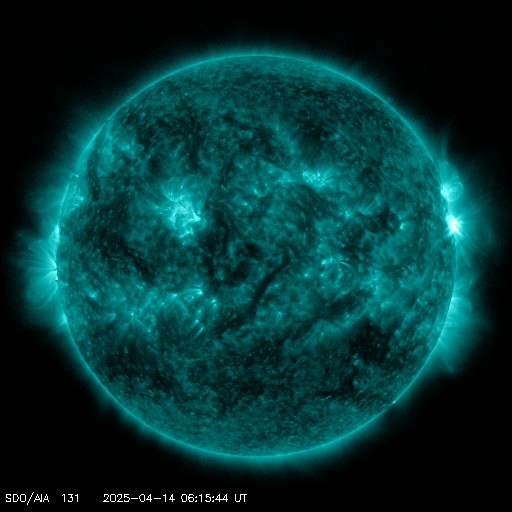Viewing archive of Thursday, 13 February 2003
Solar activity report
Any mentioned solar flare in this report has a scaling factor applied by the Space Weather Prediction Center (SWPC). Because of the SWPC scaling factor, solar flares are reported as 42% smaller than for the science quality data. The scaling factor has been removed from our archived solar flare data to reflect the true physical units.
Report of Solar-Geophysical Activity 2003 Feb 13 2200 UTCPrepared by the NOAA © SWPC and processed by SpaceWeatherLive.com
Joint USAF/NOAA Report of Solar and Geophysical Activity
SDF Number 044 Issued at 2200Z on 13 Feb 2003IA. Analysis of Solar Active Regions and Activity from 12-2100Z to 13-2100Z
Solar activity was at low levels. Region 282 (N10W45)
produced two low level C-class flares today, the largest was a C2.3
flare (location correlated using SXI imagery) that occurred at
12/2112Z. There was very little change seen in white-light coverage
or magnetic complexity during the interval, region remains a simple
beta group. Region 280 (S06W68) produced a B8.4/Sf flare at
13/0129Z and remains a very simple beta magnetic complex. A filament
eruption in the southeastern quadrant of the disk (began at
approximately 12/1330Z), seen in SOHO/EIT and SXI imagery, produced
a narrow CME (LASCO imagery) that doesn't appear as though it will
become geoeffective. No new regions were numbered today.
IB. Solar Activity Forecast
Solar activity is expected to be at
low levels.
IIA. Geophysical Activity Summary 12-2100Z to 13-2100Z
The geomagnetic field was at quiet to unsettled levels. The greater
than 2 MeV electron fluxes at geosynchronous orbit reached moderate
levels today.
IIB. Geophysical Activity Forecast
The geomagnetic field is
expected to be at quiet to unsettled levels. Day two may experience
isolated active to minor storm conditions as the leading edge of the
recurrent favorably positioned coronal hole becomes geoeffective.
Day three should be at predominantly unsettled to active levels with
minor storm conditions possible.
III. Event Probabilities 14 Feb to 16 Feb
| Class M | 15% | 15% | 15% |
| Class X | 01% | 01% | 01% |
| Proton | 01% | 01% | 01% |
| PCAF | green | ||
IV. Penticton 10.7 cm Flux
Observed 13 Feb 131 Predicted 14 Feb-16 Feb 130/130/125 90 Day Mean 13 Feb 149
V. Geomagnetic A Indices
Observed Afr/Ap 12 Feb 008/012 Estimated Afr/Ap 13 Feb 006/008 Predicted Afr/Ap 14 Feb-16 Feb 008/012-010/015-012/015
VI. Geomagnetic Activity Probabilities 14 Feb to 16 Feb
| A. Middle Latitudes | |||
|---|---|---|---|
| Active | 15% | 20% | 30% |
| Minor storm | 01% | 10% | 15% |
| Major-severe storm | 01% | 01% | 05% |
| B. High Latitudes | |||
|---|---|---|---|
| Active | 20% | 25% | 35% |
| Minor storm | 05% | 10% | 20% |
| Major-severe storm | 01% | 05% | 10% |
All times in UTC
Current data suggests there is a slight possibility for aurora to appear at the following high latitude regions in the near future
Fairbanks, AKLatest news
Latest forum messages
Ask your obscure/"stupid" space weather questions. 3552025/04/12-13 Filament CMEs 2025/04/16 G2 Watch 56Potential AR4062 9Filaments and prominences 62Incoming & Unnumbered Active Regions 1708
More topicsSupport SpaceWeatherLive.com!
A lot of people come to SpaceWeatherLive to follow the Sun's activity or if there is aurora to be seen, but with more traffic comes higher server costs. Consider a donation if you enjoy SpaceWeatherLive so we can keep the website online!

Latest alerts
Monday, 14 April 2025
23:15 UTC - Geomagnetic activity
Active geomagnetic conditions (Kp4) Threshold Reached: 23:01 UTC
07:09 UTC - Solar flare
Moderate M4.28 flare from sunspot region 4055
06:48 UTC - Radio Blackout
Minor R1 radio blackout in progress (≥M1 - current: M1.53)
06:24 UTC - Solar flare
Moderate M1.49 flare from sunspot region 4055
06:06 UTC - Radio Blackout
Minor R1 radio blackout in progress (≥M1 - current: M1.16)
Space weather facts
| Last X-flare | 2025/03/28 | X1.1 |
| Last M-flare | 2025/04/14 | M4.2 |
| Last geomagnetic storm | 2025/04/06 | Kp5 (G1) |
| Spotless days | |
|---|---|
| Last spotless day | 2022/06/08 |
| Monthly mean Sunspot Number | |
|---|---|
| March 2025 | 134.2 -20.4 |
| April 2025 | 128.8 -5.4 |
| Last 30 days | 129.1 -15.1 |





